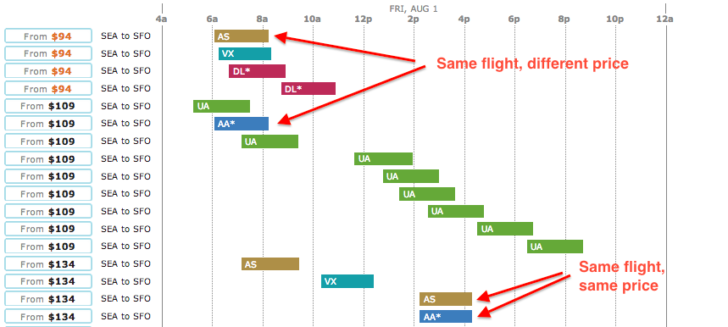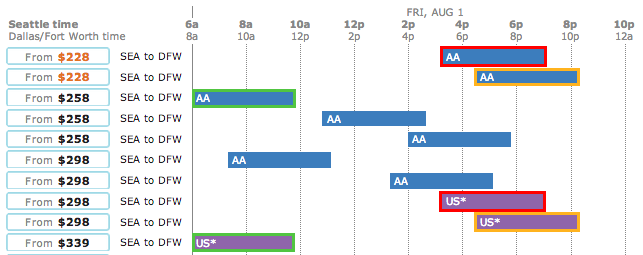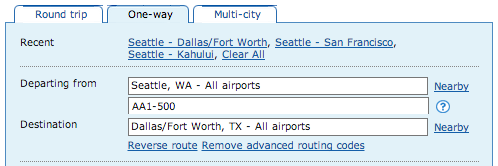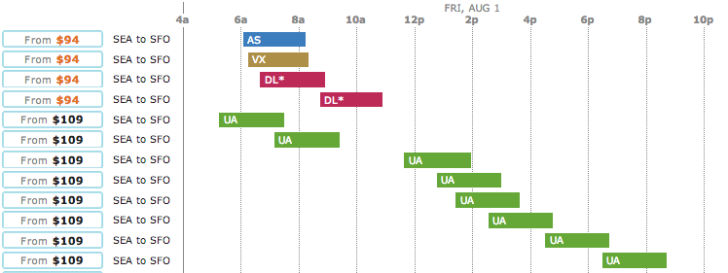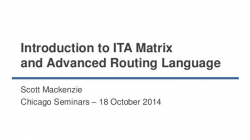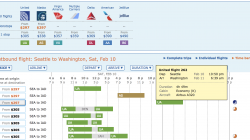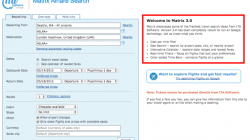Many airlines operate codeshare flights. These are flights operated by one carrier (sometimes referred to as “the metal”) but sold with a different flight number. For example, American Airlines doesn’t operate any flights between Seattle and San Francisco despite serving both airports from Dallas. But if you go to their website to buy a ticket between those two cities, they won’t make you connect in Dallas. Instead they’ll give you the option of a flight on Alaska Airlines.
If you’re not used to using ITA Matrix, I suggest you check out my three-part introductory series first:
Pulling up some examples of a one-way flight on August 1, you can fly on AS320 or AA6868, but it’s the exact same plane leaving at 6:05 AM operated by Alaska Airlines. Worth noting: there is a slight price difference involved. American wants $109 while Alaska wants $94. This isn’t always the case. Another flight leaving later that day at 2:15 PM is sold as either AS316 or AA6876 for $134 in both instances. ITA Matrix highlights them for you by using an asterisk (*).
Codeshares make it a little easier for an airline to sell tickets on routes they don’t actually serve. Maybe if you were really loyal to American and started your shopping on their site you would leave if you found no non-stop options. At least by offering a codeshare they can make a sale even if they have to share some of that revenue with Alaska. It’s not always convenient for the customer since the operating carrier’s rules apply for things check-in, elite benefits, seating assignments, and baggage fees. It can also affect how many frequent flyer miles you earn depending on the rules of your program — the same fare class on the same plane sold by two different carriers with different flight numbers might not earn the same number of miles.
For these and other reasons I try to avoid codeshares. As long as the price is the same or pretty close, I prefer to book with the operating carrier, meaning that the airline that flies the plane is the same one with the flight number on my boarding pass. You can avoid some codeshares in ITA by placing an “O:” before the carrier you want.
- “AA” will return flights with AA flight numbers, which may or may not be codeshares like AA6868.
- “O:AA” will return flights operated by AA.
One problem with using the “O:” operator is that it still allows codeshares to appear. But now they’re codeshares with other carrier’s flight numbers on planes that are operated by AA. So you may find that on a flight from Seattle to Dallas, your attempt to limit a search to flights operated by AA also returns a lot of flights with US flight numbers. (It’s much more common here, lately, to see different prices.)
You can remove even more codeshares by going a step further. Many carriers set aside some of their flight numbers for their own flights and other numbers for codeshares. Those codeshares tend to have 4-digit flight numbers, and often they’re at the high end (like “AA6868” vs. “AS320”). You can filter these sometimes by giving ITA a range: Tell it you want “AA1-500” instead of the much broader “AA” and you’ll only get results in the with flight numbers between AA1 and AA500.
NOTE: Both US Airways and American Airlines are using the same flight numbers for the codeshares to Dallas you see above, so even that isn’t a great solution.
I’ve saved the best for last. You can used a much simpler command “/nocodeshare” to just eliminate any codeshares from your results without limiting yourself to a specific carrier (notice in the previous examples that in the process of removing codeshares we also started focusing on AA instead of potentially cheaper flights operated by AS, UA, and DL that may also have been free of codeshares). There are no longer any American Airlines results between Seattle and SFO, but we also get DL, UA, and VX in addition to AS. (DL is still indicated with an asterisk because these flights are operated by a regional subsidiary, Delta Connection, but this sort of codeshare is much less likely to cause issues and can be disregarded for the purpose of today’s post.)
I could have told you that trick from the start. Instead I hope you learned a few other things along the way. There are other situations where you might feel like specifying an operating carrier or a certain flight number.
Now we’ll get to the reason behind this post. A reader asked me a few weeks ago if there was any way to look for a codeshare on purpose. Sometimes codeshares can be a great deal. Remember that slight fare difference between AS320 and AA6868? American was charging more for the codeshare, just as US is charging more for these codeshares to Dallas, but the codeshare can also be less. In fact, a large number of fuel dumps and mistake fares involve codeshares. I once flew to Spain for $500 from the West Coast on US Airways, but it was a Spanair flight number.
I don’t actually have an answer for this, nor were we able to figure out one after a few tries. As I said, this is something most people try to avoid, which is why there is a special command (and a few less perfect ways) to remove codeshares but not, apparently, one to require them. Yes, I tried some dumb ideas like “/codeshare” to no avail.
What I do recommend is trying some of the less perfect methods we discussed at the beginning of this post and trying to reverse engineer them to get your codeshare. You know you want an United Airlines flight operated by Air Canada? Then use the O:AC command to require flights operated by Air Canada and pick through them to find the United codeshares among them. Remember, ITA Matrix displays flights according to the marketing carrier, so you’ll see a big “UA” to make it easy. If you have a general idea of what the codeshare’s flight number should be, specify it exactly (AA6868) or provide a range (AA6000-9000).
Anything you can do to narrow the list of results will make it easier to identify the flights you want even if they’re still mixed in with a few you don’t. I have never done a search on ITA and gotten only one result. Nor should I. Generally, someone who knows exactly what they want doesn’t need to search for it. What I like about ITA is that it makes it easy to narrow the list from tens of thousands to just tens. I can usually take it from there.

